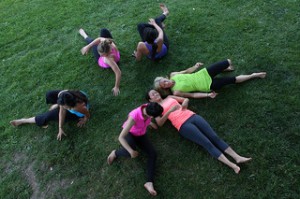Posted on 5/29/2013
Written by Liz Wassmann
 My boyfriend’s hands clench the steering wheel. We’ve gotten lost twice already as we try to find the Akiyama Wellness Center in downtown San Jose and our new class in “laughter yoga.”
My boyfriend’s hands clench the steering wheel. We’ve gotten lost twice already as we try to find the Akiyama Wellness Center in downtown San Jose and our new class in “laughter yoga.”
Troy is coming with me mostly because I need a ride, but also for moral support. He not only doesn’t believe in the class, but he’s already dreading being the only guy there. He just hopes his classmates are in the same age bracket.
Five minutes later we are standing in a circle of middle-aged women chanting, “Very good, very good, Yay!” Troy whispers to me, “I was so far off; this is so much worse than I expected.”
Now there’s no escape. We launch from the warm-up activity into the first exercise. Walking slowly in a circle, we are supposed to make eye contact with one another while laughing in beat to a chant of “Ho, Ho, Ha, Ha, Ha.” Troy is a good sport and charms all the older ladies with his great attitude, although I do notice that he deliberately avoids eye contact with me.
An elderly Japanese woman shuffles over from the front desk to pull the door shut against the raucous laughter tumbling out of the entry hall in the Wellness Center . . .which seems odd, because inside the multipurpose room, the eight of us now stand in a circle doubled over, laughing uncontrollably. The instructor, Claire Powell, is leading us through a cell-phone laughter exercise. She tells us to hold up an imaginary mobile phone and pretend like the person on the other end is telling us the best joke we’ve ever heard. The group slowly walks around the room, laughing into the imaginary phone. I have to force it at first — but the real laughter becomes real surprisingly fast as I glance around and realize how ridiculous we all look. I started out laughing at everyone else, but soon find I can’t stop. Laughter is contagious, and it doesn’t take long to learn the routine of the class and let myself let go.
The San Jose Laughter Club meets weekly with the sole intention of laughing. Laughter yoga started in 1995 in Mumbai, India and has since spread to more than sixty countries. The theory is that laughter reduces stress and lifts the spirits in an easy, healthy way. The average child laughs 400 times a day, but adults only laugh seventeen times. Across the U.S., too, laughter yoga is catching on, with clubs and groups springing up across the country.
Powell, who has been leading laughter yoga for seven years, has her own notion of why laughter yoga has become popular. In the past, household chores and farm work provided enough exercise. No one went to the gym. But just like we now have to schedule time to exercise, in our serious modern world we also need to schedule time to laugh.
The program itself is based on the principle that the body cannot differentiate between fake and real laughter. When practiced in a group, intentional laughter quickly becomes unintentional and the body and mind receive the benefits. Laughter can reduce blood pressure, stress, and pain, all while increasing endorphins and lung capacity. That’s a lot of health benefits for an activity that is free and can be practiced anywhere.
In India, thousands meet every morning in public parks, with many members boasting that they haven’t missed a day in five years or more. The effects of laughter yoga have been so profound, regular members say, they have been able to stop taking anti-depressants. In the U.S., laughter yoga is practiced mostly in California, although it is quickly spreading across the nation. The benefits are just beginning to be explored in schools, corporations, aged-care facilities, prisons, and hospitals. The group setting also provides much-needed social interaction in our increasingly online society.
SEE ALSO: 6 Totally Weird But Awesome Fitness Classes
The San Jose laughter club only meets for a half-hour on Wednesday mornings, so regular members are eager to pack in as many chuckles as they can. The session includes laughter exercises, easy stretches and deep breathing techniques. In addition to the cell phone exercise, we get in a laughter fight, make (and drink) a laughter milkshake, and laugh without making a sound.
After the class ends, Troy and I stand around chatting with the other participants. Peggy Raynor is in her sixties with penciled-in eyebrows and corkscrew black curls. She explains how she has been coming to the group for years and uses the “Very good, very good, yay!” chant with her grandchildren. Our instructor chimes in with a story about a laughter workshop she led at Peggy’s retirement community.
All those years spent laughing are evident when looking at Powell. She has a cheerful, breezy manner and is eager to explain what laughter yoga means to her. Wearing a baseball cap and yoga pants, she tells us about her training at the Laughter Yoga Institute in Laguna Beach, the first laughter club outside India to meet seven days a week. Her vision is that someday doctors will prescribe patients fifteen or twenty minutes of laughter a day, in lieu of expensive medication.
Despite his trepidations, Troy has to admit that laughter yoga really helped him to de-stress. “For the rest of the day, I still had the same workload, still had as much to do, but I just was able to smile about it,” he admits the next day. Would he like to go back to the class? “I dunno,” he says. “It is pretty silly.”
The punch line is: laughing is fun. It feels good. Powell sums her philosophy up by saying “Laughter won’t solve your problems, but it’ll get you to a point where you can.”
Liz Wassmann is on the Dot Complicated editorial team and has written for a variety of Bay Area publications over the past several years. When she’s not reading or writing, she can be found daydreaming about her next trip overseas and practicing parallel parking.












Leave A Comment
You must be logged in to post a comment.